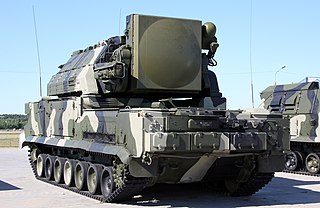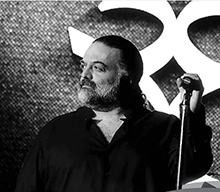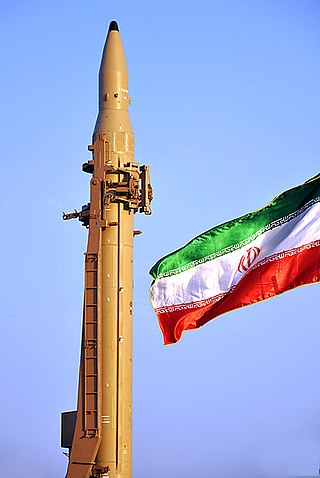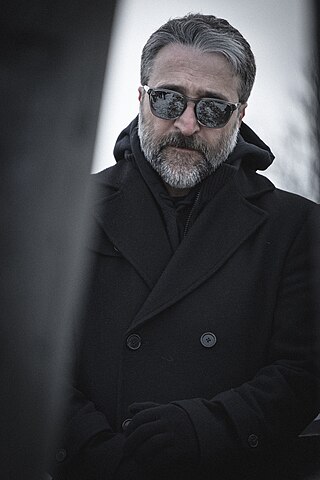Related Research Articles

The Islamic Revolutionary Guard Corps, also called Sepah or Pasdaran, is a multi-service primary branch of the Iranian Armed Forces. It was officially established by Ruhollah Khomeini as a military branch in May 1979, in the aftermath of the Iranian Revolution. Whereas the Iranian Army protects the country's sovereignty in a traditional capacity, the IRGC's constitutional mandate is to ensure the integrity of the Islamic Republic. Most interpretations of this mandate assert that it entrusts the IRGC with preventing foreign interference in Iran, thwarting coups by the traditional military, and crushing "deviant movements" that harm the ideological legacy of the Islamic Revolution. Currently, the IRGC is designated as a terrorist organization by Bahrain, Saudi Arabia, Sweden and the United States.

The 9K33 Osa is a highly mobile, low-altitude, short-range tactical surface-to-air missile system developed in the Soviet Union in the 1960s and fielded in 1972. Its export version name is Romb.

The Buk is a family of self-propelled, medium-range surface-to-air missile systems developed by the Soviet Union and its successor state, the Russian Federation, and designed to counter cruise missiles, smart bombs, fixed- and rotary-wing aircraft, and unmanned aerial vehicles. In the Russian A2AD network, Buk is located between the S-200/300/400 systems above and the point defense Tor and Pantsir type systems below.

The Tor is an all-weather, low-to medium-altitude, short-range surface-to-air missile system designed for destroying airplanes, helicopters, cruise missiles, unmanned aerial vehicles and short-range ballistic threats (anti-munitions). Originally developed by the Soviet Union under the GRAU designation 9K330 Tor, the system is commonly known by its NATO reporting name, SA-15 "Gauntlet". A navalized variant was developed under the name 3K95 "Kinzhal", also known as the SA-N-9 "Gauntlet". Tor was designed to shoot down guided weapons like the AGM-86 ALCM and BGM-34 day and night, in bad weather and jamming situations. Tor can detect targets while on the move. The vehicle must stop intermittently when firing, although trials have been conducted with the goal of eliminating this restriction.
Parand is a planned city in the Central District of Robat Karim County, Tehran province, Iran. Its toponym means "natural silk". Owned by the Parand family.

Alireza Assar is an Iranian musician and Persian pop singer and composer, and piano and guitar player.

The Pantsir missile system is a family of self-propelled, medium-range surface-to-air missile and anti-aircraft artillery systems. Three types of vehicles make up one system: a missile launcher, a radar truck and a command post. Starting with the Pantsir-S1 as the first version, it is produced by KBP Instrument Design Bureau of Tula, Russia, and is the successor to the Tunguska M1.

Since the Iranian Revolution in 1979, the Islamic Republic of Iran has been embroiled in tense relations with the U.S. and its allies. Following the hostage crisis, both countries severed relations. Since then, both countries have been involved in numerous direct confrontations, diplomatic incidents, and proxy wars throughout the Middle East, which has caused the tense nature of the relationship between the two to be called an 'international crisis'. Both countries have often accused each other of breaking international law on several occasions. The U.S. has often accused Iran of sponsoring terrorism and of illegally maintaining a nuclear program, as well as using strong rhetoric against Israel, of which Iran has questioned its legitimacy and its right to exist while supporting Hamas, an antizionist terrorist group in the Gaza Strip. Meanwhile, Iran has often accused the U.S. of human rights violations and of meddling in their affairs, especially within the Iranian Democracy Movement.

Qasem Soleimani was an Iranian military officer who served in the Islamic Revolutionary Guard Corps (IRGC). From 1998 until his assassination by the United States in 2020, he was the commander of the Quds Force, an IRGC division primarily responsible for extraterritorial and clandestine military operations, and played a key role in the Syrian Civil War through securing Russian intervention. He was described as "the single most powerful operative in the Middle East" and a "genius of asymmetric warfare," and former Mossad director Yossi Cohen said Soleimani's strategies had "personally tightened a noose around Israel's neck." In his later years, he was considered by some analysts to be the right-hand man of the Supreme Leader of Iran, Ali Khamenei, and the second-most powerful person in Iran behind Khamenei.

The Qiam 1 is a short-range ballistic missile designed and built by Iran. It was developed from the Iranian Shahab-2, a licensed copy of the North Korean Hwasong-6, all of which are versions of the Soviet Scud-C missile. The Qiam 1 entered service in 2010, with a range of 800 km (500 mi) and 100 m (330 ft) (CEP) accuracy.
Bellingcat is a Netherlands-based investigative journalism group that specialises in fact-checking and open-source intelligence (OSINT). It was founded by British citizen journalist and former blogger Eliot Higgins in July 2014. Bellingcat publishes the findings of both professional and citizen journalist investigations into war zones, human rights abuses, and the criminal underworld. The site's contributors also publish guides to their techniques, as well as case studies.

A loitering munition, also known as a suicide drone, kamikaze drone, or exploding drone, is a kind of aerial weapon with a built-in warhead that is typically designed to loiter around a target area until a target is located, then attack the target by crashing into it. Loitering munitions enable faster reaction times against hidden targets that emerge for short periods without placing high-value platforms near the target area and also allow more selective targeting as the attack can be changed mid-flight or aborted.
On 18 June 2017, under Operation Laylat al-Qadr, Iran's Islamic Revolutionary Guard Corps (IRGC) fired six surface-to-surface mid-range ballistic missile from domestic bases targeting ISIL forces in the Syrian Deir ez-Zor Governorate in response to the terrorist attacks in Tehran earlier that month. Next day, the IRGC published aerial videos recorded by the Damascus-based IRGC drones flying over the city during the operation, confirming that the missiles had successfully hit the targets with precision.
Events in the year 2020 in Iran.

Ukraine International Airlines Flight 752 (PS752/AUI752) was a scheduled international civilian passenger flight from Tehran to Kyiv, operated by Ukraine International Airlines. On 8 January 2020, the Boeing 737-800 flying the route was shot down by the Islamic Revolutionary Guard Corps (IRGC) shortly after takeoff, killing all 176 occupants on board.

The Islamic Republic of Iran and Ukraine established formal diplomatic relations on 22 January 1992. Iran recognized Ukraine as an independent sovereign state on 25 December 1991, four months after the Ukrainian SSR issued the Act of Declaration of Independence of Ukraine amidst the dissolution of the Soviet Union. Iran has an embassy in Ukraine's Kyiv, and Ukraine has an embassy in Iran's Tehran. The two countries enjoyed a generally cordial relationship with each other until January 2020, when Iran's Islamic Revolutionary Guard Corps shot down Ukraine International Airlines Flight 752, killing all of the 176 civilians onboard.

The Ukraine International Airlines Flight 752 protests were anti-government protests, forming part of the spillover clashes that took place in January 2020 resulting from the crackdown of the 2019 Iranian protests, which swept Iran in January 2020. The protests took place after it was revealed that Ukraine International Airlines Flight 752 was shot down by the Islamic Revolutionary Guard Corps of Iran, on the 8th of January 2020.

Hamed Esmaeilion is an Iranian-Canadian social activist, author, and dentist. Esmaeilion won Hooshang Golshiri Literary Awards for two of his books, Dr. Datis and Thyme is not Fair.
Iran has supported Russia both diplomatically and militarily since the beginning of the Russian invasion of Ukraine in February 2022. It has voted against United Nations resolutions condemning Russia and has regularly delivered loitering munitions, chiefly the Shahed 131 and Shahed 136, to the Russian military. Several countries have accused Iran of violating United Nations Security Council Resolution 2231, which was adopted with full support of the sitting members in July 2015 and seeks to inspect the Iranian nuclear program in preparation for ending United Nations sanctions against Iran. Additionally, Ukraine and the United States, among others, have stated that Iran's Islamic Revolutionary Guard Corps (IRGC) has had a presence in Russian-occupied Crimea for the purpose of operating Shahed drones in attacks against Ukrainian cities. Some of these IRGC personnel have reportedly been killed by Ukrainian military strikes against Russian-occupied territory; the Iranian involvement in Russia's invasion has negatively impacted Iran–Ukraine relations while intensifying existing tensions between Iran and the United States.

Javaad Alipoor is a British-Iranian theatre-maker and writer from Bradford. His work explores the interactions between technology and society, inviting audiences to engage with the kinds of technologies which shape how knowledge is created, shared and contested.
References
- ↑ "#BBCtrending: The 'rich kids of Tehran'". BBC News . 7 October 2014. Retrieved 15 January 2020.
- 1 2 3 Khorram, Yasmin (14 November 2014). "Despite ban, 'Rich Kids of Tehran' party on". CNN. Retrieved 15 January 2020.
- 1 2 "Rich Kids of Tehran on Instagram: "The actual footage from the moment the #Ukrainian flight was shot down by a Russian-made Tor-M1 missile just moments after takeoff from ..."". Instagram. Archived from the original on 26 December 2021. Retrieved 18 January 2020.
- 1 2 "The 'rich kids of Tehran'". 7 October 2014. Retrieved 20 January 2020.
- 1 2 Putnam, Lindsay (8 October 2014). "Meet the 'Rich Kids of Tehran'". New York Post . Retrieved 20 January 2020.
- 1 2 Khorram, Yasmin (14 November 2014). "Despite ban, 'Rich Kids of Tehran' party on". CNN. Retrieved 20 January 2020.
- ↑ Winsor, Ben (7 October 2014). "Instagram's 'Rich Kids Of Tehran' Shows Iranian Elites Living It Up Despite Sanctions". Business Insider . Retrieved 20 January 2020.
- ↑ Sabin, Lamiat (13 October 2014). "'Rich Kids of Tehran' clean up their online act after Iranian". The Independent . Retrieved 20 January 2020.
- ↑ Nelson, Sara C. (8 October 2014). "Rich Kids Of Tehran Instagram Account Shows A Very Different Side Of Iran". HuffPost .
- ↑ Tomlinson, Hugh (6 October 2014). "Anger at poor little rich kids of Tehran". The Times . ISSN 0140-0460 . Retrieved 20 January 2020.
- ↑ Dangerfield, Micha Barban (3 June 2015). "What the Rich Kids of Tehran Instagram Tells Us About Iranian Youth Culture". Vice . Retrieved 20 January 2020.
- ↑ Brimelow, Ben (6 January 2018). "The extravagant lives of the 'Rich Kids of Tehran' are fueling Iran's protests — take a look". Business Insider . Retrieved 21 January 2020.
- ↑ "Rich Kids of Tehran on Instagram: "Verified footage showing 2 x Tor-Missiles being fire at the #Ukrainian International Airline Flight #752 with a proximity of 30 second gap…"". Instagram.
- ↑ Browne, Malachy; Hill, Evan; Mitchell, Logan; Marcolini, Barbara (14 January 2020). "New Video Shows Two Iranian Missiles Hit Ukrainian Plane". The New York Times . ISSN 0362-4331 . Retrieved 20 January 2020.
- ↑ Kottasová, Ivana; Thornton, Chandler; Cotovio, Vasco (14 January 2020). "Iran makes arrests in connection to downing of Ukrainian jet". CNN . Retrieved 21 January 2020.
- ↑ Shahghasemi, Ehsan (28 September 2021). "Rich Kids of Tehran: The Consumption of Consumption on the Internet in Iran". Society . 58 (5): 398–405. doi:10.1007/s12115-021-00626-3. ISSN 1936-4725. PMC 8478371 . PMID 34602679.